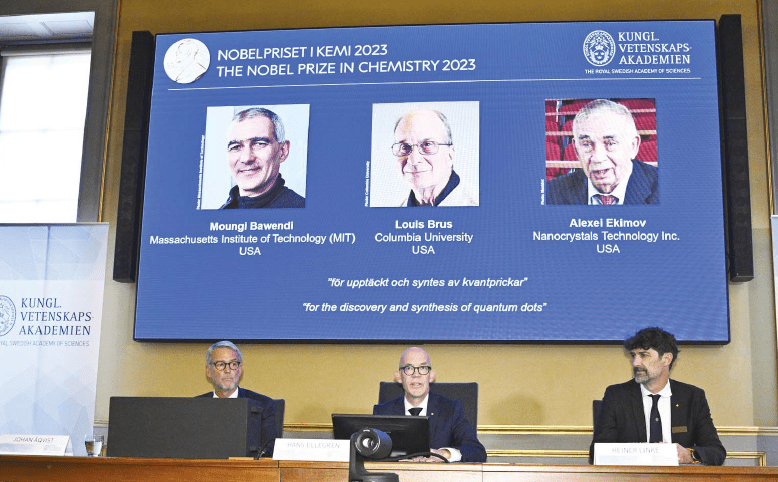04/10/2023
04/10/2023

STOCKHOLM, Oct 4, (AP): Three scientists in the United States won the Nobel Prize in chemistry Wednesday for their work on quantum dots - particles just a few atoms in diameter that can release very bright colored light and whose applications in everyday life include electronics and medical imaging. Moungi Bawendi, of MIT; Louis Brus, of Columbia University; and Alexei Ekimov, of Nanocrystals Technology Inc., were honored for their work with the tiny particles that “have unique properties and now spread their light from television screens and LED lamps,” according to the Royal Swedish Academy of Sciences, which announced the award in Stockholm.
“Why does it matter, right, that we can make tiny particles that nobody can see, but they have colors?” Pernilla Witting Stafshede, a member of the Nobel committee that awarded the prize. This is actually used today both in medicine and technology already out today. … But we have displays on TVs, in your cell phone, that use quantum dots inside to make just brighter colors.” The suspense surrounding the academy’s decision took an unusual turn when Swedish media reported the names of the winners several hours before the prize was announced. The advance notice apparently came from a news release sent out early by mistake. Quantum dots’ electrons have constrained movement, which affects how they absorb and release visible light, allowing for very bright colors.
The dots are nanoparticles that glow blue, red, or green when illuminated or exposed to light. The color they emit depends on the size of the particles. Larger dots shine red, and smaller dots shine blue. The color change is due to how electrons act in more or less confined spaces. While physicists had predicted these color-change properties as early as the 1930s, creating quantum dots of specific controlled sizes was not possible in the lab for another five decades.
Ekimov, 78, and Brus, 80, were early pioneers of the technology, while Bawendi, 62, is credited with revolutionizing the production of quantum dots “resulting in almost perfect particles. This high quality was necessary for them to be utilized in applications,” the academy said. “The community realized the implications in the mid-90s, that there could potentially be some real-world applications,” he said. Judy Giordan, president of the American Chemical Society, said she was thrilled at the selection of the winners. “What we care about a lot in chemistry is being able to make and tailor novel structures and architectures to solve problems that help people and the planet,” Girodan said.
Discovery
Swedish media reported hours before Wednesday’s announcement that the Royal Swedish Academy of Sciences had sent out a news release that identified Bawendi, Brus, and Ekimov as the latest Nobel laureates. Public broadcaster SVT said the release said the trio were receiving the prize for the “discovery and synthesis of quantum dots.” After officially announcing the three winners, Secretary-General Hans Ellegren said the Swedish academy would investigate how the information got out in advance. “There was a press release sent out for still unknown reasons. We have been very active this morning to find out exactly what happened,”, said during the news conference where the award was announced. “This is very unfortunate and we deeply regret what happened.” The academy, which awards the physics, chemistry, and economics prizes, asks for nominations a year in advance from thousands of university professors and other scholars around the world. A committee for each prize then discusses candidates in a series of meetings throughout the year. At the end of the process, the committee presents one or more proposals to the full academy for a vote. The deliberations, including the names of nominees other than the winners, are kept confidential for 50 years.
Bawendi told the news conference he was “very surprised, sleepy, shocked, unexpected and very honored.” Asked about the leak, Bawendi said he didn’t know he’d been made a Nobel laureate until he was called by the academy. He said he was not thinking about the possible applications of his work when he started researching quantum dots. “The motivation really is the basic science. A basic understanding, the curiosity of how the world works? And that’s what drives scientists and academic scientists to do what they do,” he said. Brus said he didn’t pick up the phone when the early morning call came from the Swedish academy to notify him. “It was ringing during the night, but I didn’t answer it because I’m trying to get some sleep, basically,” he told The Associated Press. He finally saw the news online when he got up around 6 a.m. “I certainly was not expecting this,” Brus said. Brus said he was glad to see recognition for the area of chemistry he practices. The practical applications of quantum dots, like creating the colors in flatscreen TVs, are something he was hoping for when he started the work decades ago, he said.


